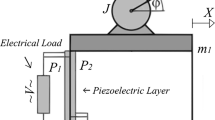Abstract
Self-powered chaos signal generator is potentially useful in future medical system, such as low cost portable human healthy monitor and treatment without external power source. For both functional and power unit, the power level of electric energy generator and consumption is a key factor for self-powered system. In this paper, we have investigated the power consumption of three typical output modes of a simple chaos circuit. Analytical analysis for power consumption of fixed output mode is obtained for evaluating the power characteristics of chaos signal generator. Numerical calculations are given for predicting the power characteristics of periodical and chaotic output modes. This study is important for not only understanding the power consumption of chaos signal generator, but also guiding new self-powered chaos signal generator design.
Similar content being viewed by others
References
Lorenz E N. Deterministic nonperiodic flow. J Atmos Sci, 1963, 20: 130–141
Radzicki M J. Institutional dynamics, deterministic chaos, and selforganizing systems. J Econ Issues, 1990, 24: 57–102
Skarda C A, Freeman W J. Chaos and the new science of the brain. Concept Neurosci, 1990, 1: 275–285
Lombardi F. Chaos theory, heart rate variability, and arrhythmic mortality. Circulation, 2000, 101: 8–10
Wang Z L, Wu W Z. Nanotechnology-enabled energy harvesting for self-powered micro-/nanosystems. Angew Chem Int Ed, 2012, 51: 11700–11721
Wang Z L, Song J H. Piezoelectric nanogenerators based on zinc oxide nanowire arrays. Science, 2006, 312: 242–246
Wang X D, Song J H, Liu J, et al. Direct-current nanogenerator driven by ultrasonic waves. Science, 2007, 316: 102–105
Qin Y, Wang X D, Wang Z L. Microfibre-nanowire hybrid structure for energy scavenging. Nature, 2008, 451: 809–813
Yang Y, Wang S H, Zhang Y, et al. Pyroelectric nanogenerators for driving wireless sensors. Nano Lett, 2012, 12: 6408–6413
Yang Y, Guo W X, Pradel K C, et al. Pyroelectric nanogenerators for harvesting thermoelectric energy. Nano Lett, 2012, 12: 2833–2838
Fan F R, Tian Z Q, Wang Z L. Flexible triboelectric generator. Nano Energy, 2012, 1: 328–334
Fan F R, Lin L, Zhu G, et al. Transparent triboelectric nanogenerators and self-powered pressure sensors based on micropatterned plastic films. Nano Lett, 2012, 12: 3109–3114
Xue X Y, Wang S H, Guo W X, et al. Hybridizing energy conversion and storage in a mechanical-to-electrochemical process for selfcharging power cell. Nano Lett, 2012, 12: 5048–5054
Xue X Y, Deng P, Yuan S, et al. CuO/PVDF nanocomposite anode for a piezo-driven self-charging lithium battery. Energy Environ Sci, 2013, 6: 2615–2620
Zhang Y, Zhang Y, Xue X, et al. PVDF-PZT nanocomposite film based self-charging power cell. Nanotechnology, 2014, 25: 105401
Wang S H, Lin Z H, Niu S M, et al. Motion charged battery as sustainable flexible-power-unit. ACS Nano, 2013, 7: 11263–11271
Matsumoto T A. Chaotic attractor from Chua circuit. IEEE Trans Circuits Syst, 1984, 31: 1055–1058
Author information
Authors and Affiliations
Corresponding author
Rights and permissions
About this article
Cite this article
Zhang, Y., Yang, Y. & Zhang, Y. Theoretical study of electric energy consumption for self-powered chaos signal generator. Sci. China Technol. Sci. 57, 1063–1067 (2014). https://doi.org/10.1007/s11431-014-5544-y
Received:
Accepted:
Published:
Issue Date:
DOI: https://doi.org/10.1007/s11431-014-5544-y




